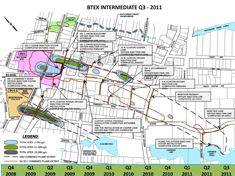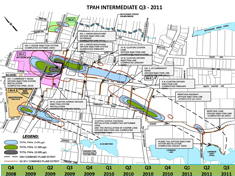OU-3 Cleanup Progress
OU-3 is at the western end of the site and contains the Brightwaters Yard portion of the original plant site west of Fifth Avenue, where fuel for the gas-making process was stored, and the plume of contaminated groundwater which originates in this area and extends southward as a narrow band in the vicinity of Lanier Lane. A large fuel storage tank and associated piping once stood in this area, containing a kerosene-like petroleum product that was used as the feedstock for the gas manufacturing process. Several other, smaller tanks were also present.
As was the case with OU-1 and OU-2, the cleanup strategy in OU-3 has been to remove as much of the contaminated source material as possible from the original MGP plant site, and to introduce oxygen into the groundwater to encourage soil bacteria to consume the contaminants that have already dissolved in groundwater and migrated beyond the site boundaries.
Contaminated soil in the Brightwaters Yard was removed during several rounds of excavation. The most recent effort in 2010 included temporary relocation of the LIRR tracks adjacent to the site to allow excavation of contaminated soil below the tracks.
A line of oxygen injection wells, similar to those in OU-2, was installed along the south side of Union Boulevard in 2000. This system was replaced in 2010 with a new system located on the north side of Community Road. An area of high groundwater contaminant concentrations remains in the area between the 2010 LIRR excavation and the new oxygen injection line. In response, National Grid upgraded the new Community Road injection system in 2012. Although performance has improved, this area still does not appear to be responding adequately to the cleanup efforts completed to date. NYSDEC recently approved a proposal by National Grid to install additional oxygen injection wells in this area to accelerate the destruction of groundwater contamination.
In the residential area along Lanier Lane, south of Union Boulevard, contaminant levels have declined sharply. Some pockets of contaminated groundwater remain. The same general pattern of contaminant decline observed in OU-2 is under way in OU-3, with deeper groundwater contamination taking longer to respond to the addition of oxygen.
A small area of shallow groundwater contamination was identified near the intersection of Lanier Lane and Cooper Lane in early 2013. A detailed investigation was performed to determine the scope of the problem. Once results were received from 13 temporary sampling points and five additional long-term monitoring wells, it became clear that the zone of shallow contamination was very small, centered on a single property. It appears that the installation of an upgraded basement dewatering system was drawing more heavily impacted groundwater upward from the deeper plume.
In response, National Grid installed a treatment system to remove contaminants from the water being produced by the basement pumping system. Under direction from NYSDEC, National Grid also initiated a more direct strategy for increasing oxygen levels in the surrounding groundwater beneath the property. To expedite the treatment, a series of 21 ORC slurry-injection points were installed surrounding the small contaminated area. These points serve the same purpose as the oxygen gas injection wells, but they are much simpler and quicker to install. The slurry consists of a chemical compound that slowly dissolves and releases oxygen over a time period of several months. Preliminary results show that oxygen levels are increasing and contaminant levels are beginning to decline. This pattern is expected to continue as the slurry slowly dissolves and delivers oxygen throughout the surrounding area. Contaminant levels are being monitored weekly and additional slurry injections will be performed as necessary to ensure effective groundwater treatment.
NYSDEC and the Suffolk County Department of Health Services (SCDHS) conducted follow-up inspections of residences in OU-3 to determine if there have been any changes in conditions since Super Storm Sandy.



